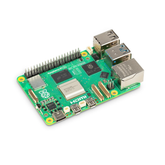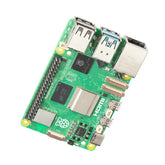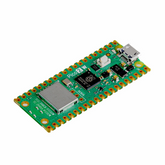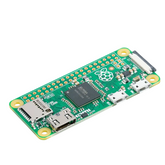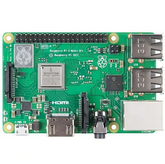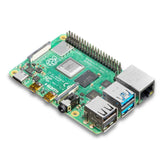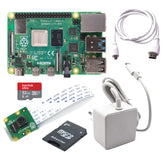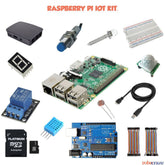What is Raspberry Pi
Summary
Hey there, tech enthusiasts! In this blog post, I'm super excited to talk to you about something truly amazing in the world of DIY electronics - the Raspberry Pi.
If you've been curious about DIY electronics, coding, or creating your own tech projects but didn't know where to start, you're in the right place!
So what exactly is a Raspberry Pi? Let's know in this detailed blog!
Introduction
Raspberry Pi is a complete computer that's smaller than your notebook and costs less than a pair of good headphones. That's the Raspberry Pi - a tiny but mighty computer.
The cool thing about Raspberry Pi is that it can do almost everything a regular computer can do - browse the internet, play videos, create documents - but it also lets you connect wires and circuits directly to it, which means you can use it to control lights, sensors, motors, and build amazing projects.
Originally created to help students learn programming and computer science, the Raspberry Pi has grown far beyond classrooms. Today, these tiny computers power everything from homemade robots to smart home systems, retro gaming consoles, and even high-tech farming equipment.
What makes me most excited to share this with you is that the Raspberry Pi was specifically designed to be beginner-friendly and affordable. You don't need to be a tech genius to get started - just curiosity and creativity. Throughout this blog series, I'll show you how to set up your first Pi, run some cool programs, and eventually build projects that will impress your friends and family.
So, whether you're looking to learn coding, create awesome DIY gadgets, or just understand how computers actually work, the Raspberry Pi is your perfect starting point. Let's dive into this amazing world of possibilities together!
Learn how to use a Raspberry Pi for your first project like a pro!
What is Raspberry Pi All About?

Let's dive deeper into what makes the Raspberry Pi so special. At its core, it is what tech folks call a "single-board computer." This means all the important parts of a computer-the processor, memory, and connections-are built onto one small circuit board.
Unlike your laptop or desktop computer, the Raspberry Pi doesn't come with a screen, keyboard, or mouse. It doesn't even come with a case!
What you get is the bare board with various ports and connectors that let you hook it up to other devices. This might sound limiting at first, but it's actually what makes the Pi so versatile and perfect for creating custom projects.
The Raspberry Pi runs on a special version of Linux (an operating system like Windows or macOS) called Raspberry Pi OS. This software is free and designed to be easy to use, even if you're new to computers.
Thinking of buying a Raspberry Pi? Read now Why Buy a Raspberry Pi?
What Are the Different Models of Raspberry Pi?

The Raspberry Pi family has grown quite a bit since it was first introduced. Here are the main models you'll find today:
Raspberry Pi 5:
This is the newest and most powerful model, released in late 2023. It features a quad-core processor running at 2.4GHz, up to 16GB of RAM, and much faster performance than previous models.
Raspberry Pi 4:
Still very popular, this model comes with 2GB, 4GB, or 8GB of RAM options and is powerful enough to use as a desktop computer replacement for basic tasks.
Raspberry Pi 3B+:
This reliable mid-range model, released in 2018, features a 1.4GHz quad-core processor, 1GB of RAM, improved dual-band Wi-Fi, Bluetooth 4.2, and faster Ethernet, making it perfect for IoT projects and lightweight applications.
Raspberry Pi Zero:
This ultra-small version is about the size of a stick of gum! It's perfect for projects where space is limited, like wearable tech or tiny robots.
Raspberry Pi Pico:
Unlike the others, this isn't a full computer but a microcontroller (like Arduino) designed specifically for controlling electronic components in DIY projects.
Each model serves different needs, which brings us to an important question...
Confused between Arduino and Raspberry Pi? Arduino vs Raspberry Pi blog clears it up
What is the Best Raspberry Pi?
The "best" Raspberry Pi board depends entirely on what you want to do with it! Here's a quick guide:
For beginners just learning: The Raspberry Pi 4 with 4GB RAM is a great starting point. It's powerful enough for most projects but won't break the bank.
For the absolute latest and fastest: The Raspberry Pi 5 is the way to go, especially if you want to use it as a desktop computer or for demanding projects like AI or video processing.
For reliable performance on a budget: The Raspberry Pi 3B+ is an excellent choice with its 1.4GHz quad-core processor and 1GB RAM. It's perfect for IoT projects, media centres, and learning programming without the higher cost of newer models.
For ultra-compact projects: The Raspberry Pi Zero 2W gives you wireless capabilities in the smallest package.
For simple electronics projects: The Raspberry Pi Pico is incredibly affordable and perfect for controlling LEDs, motors, and sensors.
Wondering if Raspberry Pi 5 is worth it? Find out in our detailed Raspberry Pi 5 Review!
Which Processor is Used in the Raspberry Pi?

The processors in Raspberry Pi boards have evolved significantly over time. The latest Raspberry Pi 5 uses a Broadcom BCM2712 quad-core Cortex-A76 processor running at 2.4GHz. It's about 2-3 times faster than the previous generation!
The Raspberry Pi 4 uses a Broadcom BCM2711 quad-core Cortex-A72 processor running at 1.5GHz, which is still plenty powerful for most projects.
These processors are similar to what you might find in some smartphones, but optimized for the Raspberry Pi's unique needs. They're designed to provide good performance while using minimal power, which is why many Pi projects can run on a simple USB power supply.
Raspberry Pi 5 vs Raspberry Pi 4 Model B – What’s changed? Read the detailed comparison.
What is the Primary Purpose of the Raspberry Pi?
The Raspberry Pi was originally created with one clear mission: to make computing and programming accessible to students. The Raspberry Pi Foundation, the UK-based charity that develops these devices, wanted to create an affordable computer that would help young people learn about technology, coding, and computer science.
While the Pi has expanded far beyond education, teaching remains at its heart. The low cost means schools can afford to provide hands-on computing education to students. The open nature of the platform encourages experimentation and learning by doing.
Is Raspberry Pi Python or Java?
This is a common question, and the answer is: neither! The Raspberry Pi is hardware, not a programming language. However, it does come pre-installed with Python, which is why many people associate the two.
Python is the recommended language for beginners on the Raspberry Pi because it's relatively easy to learn and incredibly powerful. The "Pi" in Raspberry Pi actually comes from Python creators wanted to emphasize this connection!
That said, you can program the Raspberry Pi using almost any language you want:
- Python (most popular and beginner-friendly)
- Scratch (visual programming for absolute beginners)
- Java
- C/C++
- JavaScript
- And many others!
This flexibility is one of the things that makes the Pi so useful for learning programming-you can start with simple languages and progress to more complex ones as your skills develop.
Who Needs Raspberry Pi?
The better question might be: who doesn't? The Raspberry Pi has found its way into the hands of:
Students and learners: From primary school children taking their first steps in coding to university students building complex engineering projects, the Pi is an educational powerhouse.
Hobbyists and makers: If you enjoy DIY projects, the Raspberry Pi opens up endless possibilities for creating custom gadgets and automating your home.
Professionals and developers: Many software developers and IT professionals use Raspberry Pis for testing, prototyping, or specialized tasks like network monitoring.
Small businesses: The affordable Pi has become popular for digital signage, point-of-sale systems, and other business applications where a full computer would be overkill.
Raspberry Pi Uses and Projects

The possibilities with Raspberry Pi are nearly endless, but here are some popular and useful projects to inspire you:
- Smart Home Hub: Control lights, fans, air conditioners, and other devices in your home using a Raspberry Pi running software like Home Assistant.
- Retro Gaming Console: Install RetroPie software and connect your Pi to a TV to play thousands of classic games from the 80s and 90s.
- Weather Station: Connect sensors to measure temperature, humidity, and air quality, then display the data on a small screen or send it to your phone.
- Security Camera: Use the Raspberry Pi Camera Module to create a customizable security system that can detect motion and send alerts.
- Digital Photo Frame: Display your favourite photos in a rotating slideshow using a Pi connected to a monitor or small display.
- Personal Web Server: Host your own website or create a file server to access your documents from anywhere.
- Music Streaming Box: Create a device that can play music through your home speakers using services like Spotify or your own music collection.
Try these Top 10 Raspberry Pi projects for beginners – Read now
How to Use Raspberry Pi?

Getting started with your first Raspberry Pi is simpler than you might think:
- Gather your equipment: Besides the Pi itself, you'll need a microSD card (8GB minimum, 32GB recommended), a power supply (USB-C for newer models), an HDMI cable, and a keyboard and mouse.
- Set up the operating system: Download the Raspberry Pi Imager software on another computer, and use it to install Raspberry Pi OS onto your microSD card.
- Connect everything: Insert the microSD card into your Pi, connect the keyboard, mouse, and display, then plug in the power.
- Follow the setup wizard: The first time you boot up, a setup wizard will help you configure your language, connect to Wi-Fi, and update your software.
- Explore and learn: Once setup is complete, you can start exploring the desktop environment, try some programming in Python, or begin working on your first project!
The beauty of the Raspberry Pi is that you don't need to be an expert to get started. There are thousands of tutorials online, a helpful community of users, and plenty of resources specifically designed for beginners.
Got a Raspberry Pi 5? Try these 5 fun Raspberry Pi 5 beginner projects – Read now
Conclusion: Why Raspberry Pi Matters
In a world where most of our technology comes in sealed boxes that we're not supposed to open or modify, the Raspberry Pi represents something different invitation to explore, tinker, and create. It gives you the freedom to build technology that serves your specific needs rather than just consuming what big companies decide to sell.
For young people in India especially, the Raspberry Pi offers an affordable entry point into the world of technology creation. The skills you develop while working with Pi-programming, electronics, problem-solving are exactly the skills that will be valuable in the future job market.
Whether you dream of becoming a software developer, an electronics engineer, or just want to understand the technology that surrounds us, the Raspberry Pi provides a hands-on way to learn that's both fun and practical.
So what are you waiting for? The world of Raspberry Pi is ready to explore, and your next amazing project might be just a tiny computer away!
If you appreciate our work, don't forget to share this post with your friends and leave your opinion in the comment box.
Also read, Top Raspberry Pi Alternatives
Check out our wide range of collection - Unbeatable Price Guaranteed - Click Here



